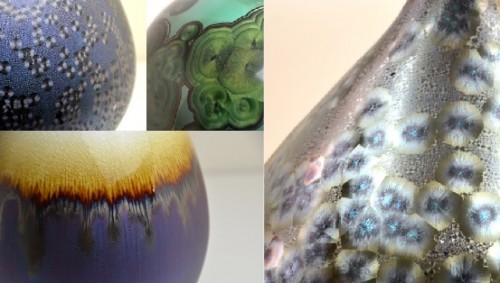
2013.10.4
A Japanese ceramic artist based in Boston, USA
Ceramics fired in America and Japan; not surprisingly, being made from different natural materials they naturally differ.
While in the land of America, my background as a Japanese responds somehow or other, and my works are created.
[Iwaseki] When you relocated your base to America, even though you applied all the techniques and knowledge you had gained while studying under Shurei Miura in Japan, I guess everything was a challenge from the very beginning.
[Miyamura] Yes, it was. Despite over 10,000 experiments in Japan, I tried mixing the same compounds in America, but the works did not come out at all as I wanted. There was also a problem with the clay. I think among the glazes, feldspar is quite important, but I was unable to find the particular feldspar I was used to in Japan. Fortunately, since the American continent is so vast, I found there were four or five types of feldspar I could buy, so I tried using the one closest to the Japanese, but even so, things did not go well; consequently, I abandoned everything and started again from zero. After I moved to America, I noticed that to produce the effects I wanted, I had to use a higher temperature than in Japan. In Japan, about 1,220 degrees was the limit, but by taking advantage of the performance of an American kiln, I raised the temperature to 1,320 degrees or so; American clay withstands such high temperatures and maintains its shape.
[Iwaseki] So, it is an ideal clay for high-temperature firing, but how much does the size and shape change?
[Miyamura] The piece contracts by about 20 percent. It is quite different.
[Iwaseki] Some of the vivid iridescent glazes developed by you have names. Could you introduce a couple of them?
[Miyamura] Well, about 10 years ago I successfully stabilized production of my “Starry Night” glaze. I named it after the painting by van Gogh; it is truly starry night just like his night sky. Depending on the light’s direction, this crystal glaze shines in circles. During the first solo exhibition in Japan four year ago, this glaze was very popular, but this time, almost no Starry Night glaze works will be displayed, because I don’t know why, but this glaze is no longer stable.
“Hare’s Fur Glaze.” In Japan there is a glaze known as rabbit fur glaze, but mine is hare; the name has a feel of wildness, right? This exhibition shows many works from the “Snow cap” series, in which white glaze is laid on top of the Hare’s Fur Glaze. As for the rest, “Sea Form.” It was four years ago, wasn’t it, Ms. Iwaseki?
[Iwaseki] Yes, it was when I visited your studio before your solo exhibition. I made a special request to you about displaying the “Sea Form” works (laughter).
[Miyamura] At that time, I had produced only three or four pieces in five years; it was a glaze that really did not come out very often. I kept them safe in my studio, but you spotted them and then exhibited the pieces. After they left my studio, I worked again on the glaze from the beginning and I was successful. I was able to produce quite a number of exhibits, but it is still a difficult glaze, and for the past four years, I kept them hidden. I had always wanted them to be shown in Japan and I’m so glad that they will be seen by everyone now.
[Iwaseki] It is truly a privilege. I am looking forward to seeing everybody’s reaction.
[Iwaseki] Lastly, may I ask you a few questions, I was wondering when you create a work, is there any particular kind of image you hold in your mind? What has affected or inspired you most? And in terms of art, what was most striking for you in the past?
[Miyamura] The moment that made me choose this path was seeing a yohen tenmoku Chinese tea bowl. Recently, the chance encounter that has most affected my creativity was when I saw the work of an Italian glass artist, Lino Tagliapietra, at the Renwick Gallery of the Smithsonian Museum. When I met his works, I was filled by an impulse to create blown glass shapes in ceramics formed against gravity.
[Iwaseki] That is a wonderful story. The Smithsonian Museum also has your work in its permanent collection. Thank you very much for today.
